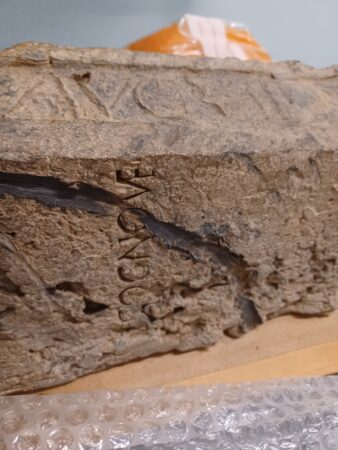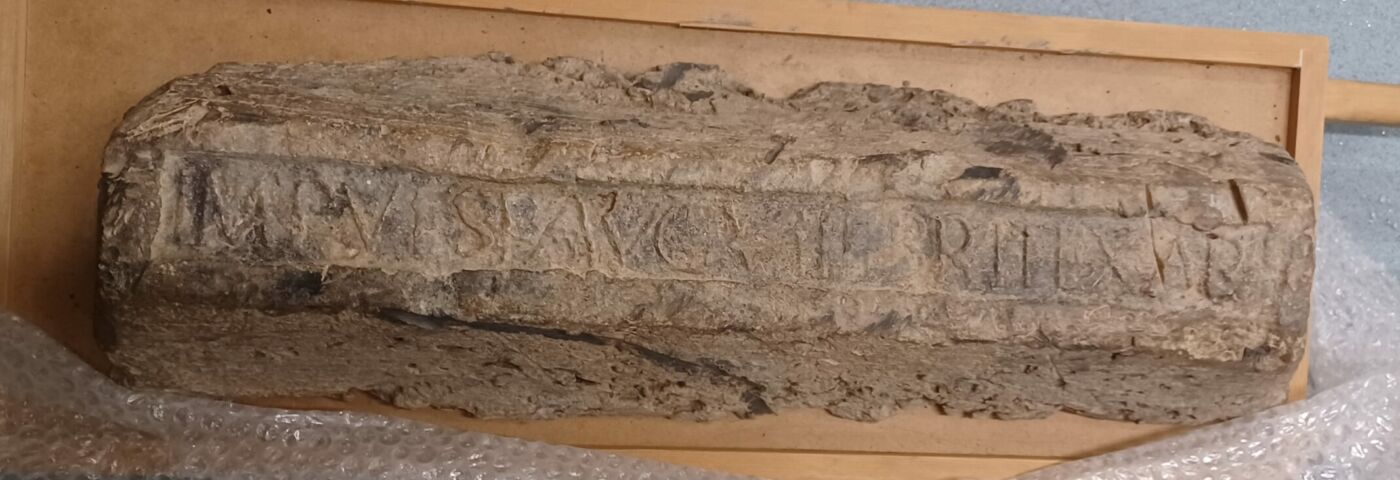Blog post by Phillip Brant-Simmons, Collections Engagement Assistant
We have many strange and fantastical things in our stores and I recently had the chance to do a little bit of research into this very large (and heavy) object that isn’t on display. It was found in Syde in 1962 by one Major S.P.H. Simonds while he was ploughing his field. This object is called a lead ‘pig’, but it doesn’t resemble the animal at all, and is a nice big lump of lead. There’s no lead in the Cotswolds and so this must have travelled some distance to get to northern Gloucestershire.
I found a lot of information about it from an article in TBGAS (Transactions of the Bristol and Gloucestershire Archaeological Society. Report 103 from 1985) which enlightened me about these objects and has given me a greater understanding of what this object is in our stores.

There is a very impressive stamp along the top of the pig which reads:
IMP ◦ VESP ◦ AVG ◦ VIIII ◦ BRIT ◦ EX ◦ AR
Now writing out the whole phrase would mean the stamp would need to be really small, or the pig would need to be really long, so they just stamp in the important letters that are usually quite easy to work out what the rest of the word says. The full Latin would read:
Imp(eratore) Vesp(asiano) Aug(usto) VIIII (plumbum) Brit(annicum) ex ar(gentariis[1])
This translates to:
In the 9th consulship of the Emperor Vespasian Augustus British (lead) from the silver mines.
Telling us that the stamp came from the 9th consulship of the Emperor Vespasian allows us to date the object with absolute certainty, and so we know that this dates to AD79, the last year of the reign of Vespasian.

There is also a stamp of C◦P◦Ɔ, which was probably the name of the official presiding over the mines whose job it was to ensure the quality of the raw material coming out of the mines in the area. The first two letters can be guessed as Gaius Publius, but the third name will probably always be a mystery, with us only knowing that it began with a ‘C’.
The main lead mine that the Romans used was in the Mendips in Somerset, and it was the local government that had control over the mines, hence the stamp bearing the name of the Emperor. The lead from the Mendips was of good quality and it was transported not just throughout Britain but to other parts of the Empire, probably being transported out of Southampton where two other lead pigs were found. A small number of pigs have been found in France which have been tested to be shown to have come from the Mendips, and there’s even some lead in a cistern in Pompeii was almost certainly from the same lead mine in the Mendips. There have been a number of lead pigs found in Britain, and the majority of them have had the Emperor Vespasian’s name stamped upon it. This indicates that the mines in the Mendips were most active during his ten-year reign. Emperor Vespasian ruled from AD 69-79, and the eruption of Vesuvius was in AD 79, the last year of his reign.
[1] This is one likely answer for filling in this word. One other possibility is that it is saying that it is ex argento meaning without silver. Implying it either came from the mine which wasn’t the silver mine which was in the area, or it is had its silver removed. Spectroscopy revealed that it is 0.00324% silver, which is pretty good going I’d say.










